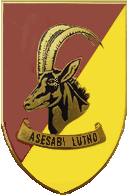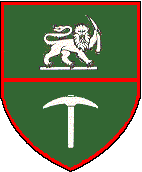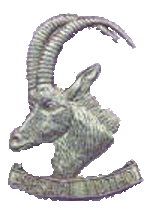Web Site Home Page The Armoured Corps Roll of Honour The Regiment Uncovered Gallery
ORIGINS
The Rhodesian Armoured Car Regiment (Rh ACR) first saw service in
Abysinnia and North Africa in 1941-2 under Lieut-Col Blakiston-Houston,
who gave his name to Rh ACR's base in Salisbury. Its original equipment
was South African-built Marmon Herrington armoured cars (armed only
with a Bren .303 (7.62mm) light machine gun), which the BSAP Armoured
Car Unit continued to use for urban riot control until 1972, by which
time they were 30 years old! Rh ACR was reformed after World War II,
and equipped with 20 American Staghound armoured cars, but again
disbanded in the 1950s. The Staghounds, which by then had passed to
Support Group, 1 RLI, were moved to Kariba for border defence at the
time of UDI in 1965, and one of them marked the event by firing a
symbolic 37mm round in the direction of Zambia.
Rh ACR was reformed in 1972 as a Territorial unit under the command of
Major Bruce Rooken-Smith. Its main equipment was the Ferret scout-car,
armed with a single .303" (7.62mm) machine-gun. This 2-man vehicle was
intended for light reconnaissance.
Rh
ACR ORGANISATION
Initially, the Regiment consisted of 4 squadrons (A-D) each consisting
of 4 troops of 4 vehicles. "C" squadron consisted of regular personnel.
The others were made up largely of Territorials who were selected for
Rh ACR, and given 6 weeks' specialised training in armoured warfare,
vehicle handling, and gunnery followed by a 1-week crash course on mine
countermeasures.
Clearly, only 64 purpose-built
recce vehicles couldn't meet all the mobile tactical reconnaissance
needs of a country half as big again as the UK. Hence, many of the
local recce, routine patrol, and convoy protection, duties fell to
locally-raised forces such as PATU reserve, using vehicles such as the
Leopard already described. "George" and his companions tended to be
used where fast, specialised recce vehicles were most needed ("his
fire-power's might handy..."). In practice, this meant sensitive border
areas and external ops, where elements of the Armoured Car Regiment
were allocated at Squadron, or even Troop, strength to "Independent"
(Indep) Companies.
Rh ACR's
CONTRIBUTION TO AN ALL-ARMS TEAM
"Indep"
companies contained armoured cars, along with elements of the Rhodesian
Artillery with their 25-pdr guns, Infantry, and Engineers with
mine-lifting skills. The Indep companies were "parented" by Rhodesia
Regiment until 1977, and subsequently by RAR. There was a cadre of
regular officers, but most of the manpower for all elements of the
Indep companies (Infantry, Armour, Artillery, and Engineers) came from
national servicemen on their initial 2-year call-up, or from
Territorials doing their (increasingly) regular 6-8 week tours of duty.
The Indep Companies were deployed as follows. 1 and 4 were
based at Wankie, (Operation "Tangent") covering Rhodesia's NW and SW
borders, sandwiched between ZIPRA's main base areas in Zambia and
Botswana. 2 was based at Kariba (Op "Hurricane"), covering ZIPRA's
other main infiltration routes across Lake Kariba and the lower Zambesi
Valley. 3 Indep, based at Inyanga, and 5 and 6, based at Umtali,
(Operation "Thrasher') shared between them the unenviable task of
covering ZANLA's innumerable infiltration routes into Rhodesia from its
bases in Mozambique.
NEW EQUIPMENT -
AND AN EXPANDING ROLE
In the last years of the
war, Rh ACR was expanded and restructured to face the threat of
"classical warfare" anticipated by the Rhodesian Army. D Squadron was
equipped with MPCVs and expanded to include the armoured infantry which
fought in them. It took part in extensive exercises on Somabula Plain
in 1980 with the elements of 1 and 2 RAR which had been earmarked, and
were undergoing extensive training, to operate as a mechanised infantry
battalion. The MPCV was well-designed to operate alongside the Eland,
and indeed was far superior to the obsolescent BTR 152s supplied by the
Soviets to ZIPRA fo use in classical warfare alongside equally
obsolescent T-34s. The only incident which tested this combination took
place after the 1980 settlement at Entumbane. The fact that this
abortive coup proved to be the end of ZIPRA's aspirations to political
power speaks for itself.
CLASSICAL
TANKS FOR A CLASSICAL WAR
Rh ACR was the
unlikely beneficiary of the fall of the Ugandan dictator !di Amin. A
freighter laden with T-55 tanks from Libya destined for him sought
refuge in Durban after his atrocious regime had been toppled -
ironically by similar tanks operated by the Tanzanians! The South
Africans appropriated the tanks "in lieu of port dues", and offered
them to the Rhodesians, who used them to equip the newly-formed E Sqn
Rh ACR. They took part in the 1980 exercises described above, and it is
rumoured that they were ready to roll in a coup planned at the time of
the 1980 election. This scenario would make a fascinating plot for a
thriller, because there is little doubt the tanks' influence could have
been crucial. Subsequent photos show these tanks, supplemented by
others of the same type, being used by ZNA's North Korean-trained 5th
Brigade.
OTHER Rh ACR EQUIPMENT
E Sqn also had a number of T-34/85 tanks, which were said to have been
captured from FRELIMO oncross-border raids. Bruce Rooken-Smith doubts
this, and suspects they were supplied after the 1980 settlement from
ZIPRA sources. One of these T-34s now reposes in the Army Museum at
Bulawayo, but these aged and unreliable vehicles were never highly
regarded, or much used, by either Rhodesian or Zimbabwean Armoured
Corps.
In 1979, Rh ACR acquired Magirus-Deutz
transporters for its tanks from South Africa. Because these vehicles
were acquired late, they were not mine-protected like the earlier
Leyland vehicles dubbed "Muppets". These had a trailer designed by Rio
Tinto Zinc which could be used to transport up to 3 Elands, but was
incapable of handling a T-55.


 Cap Badge
Cap Badge















